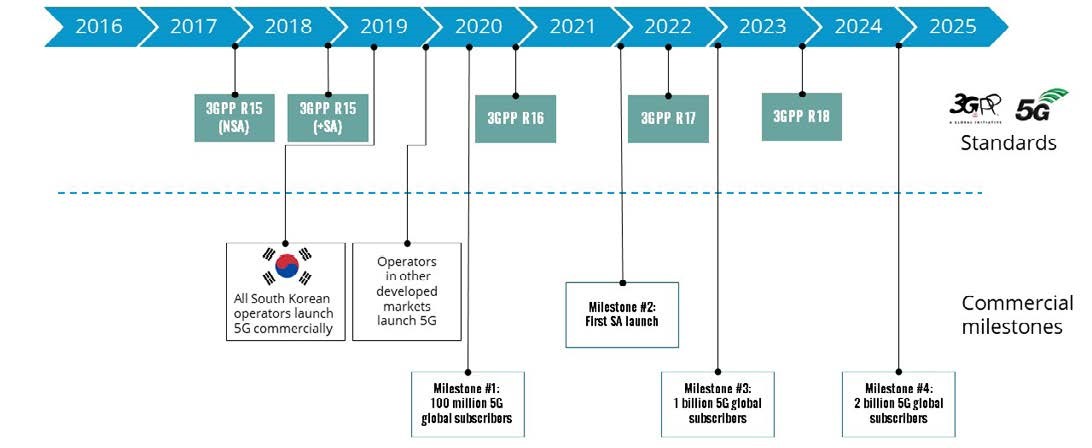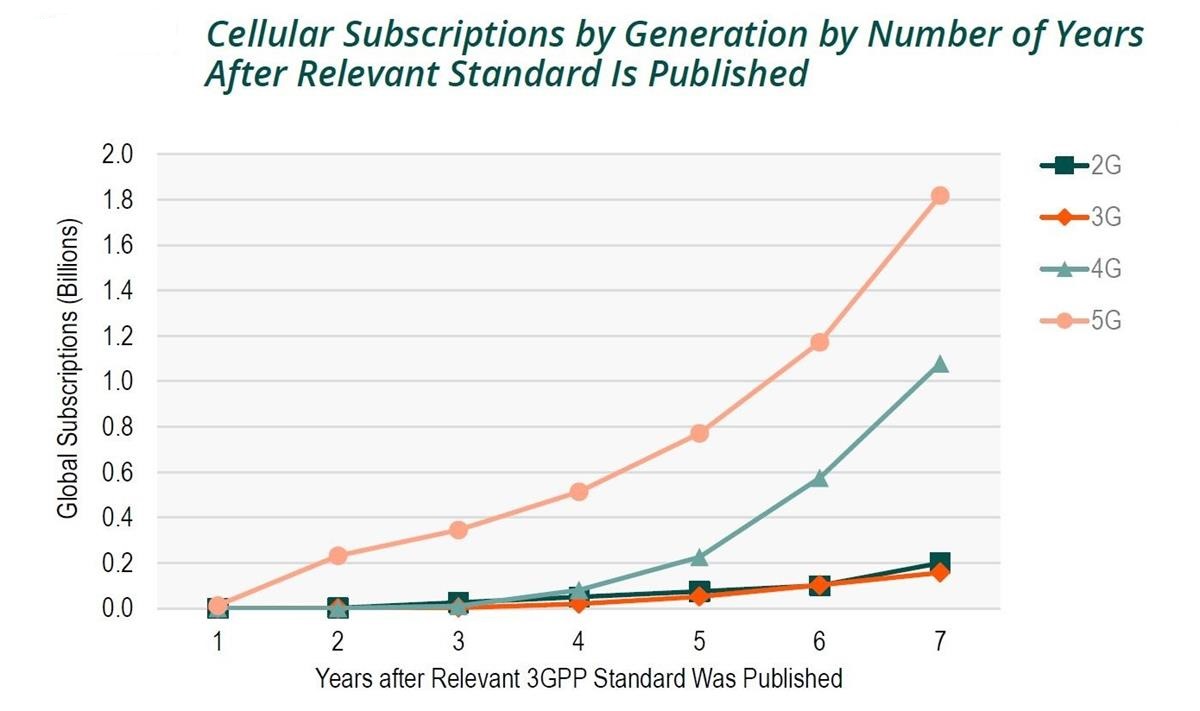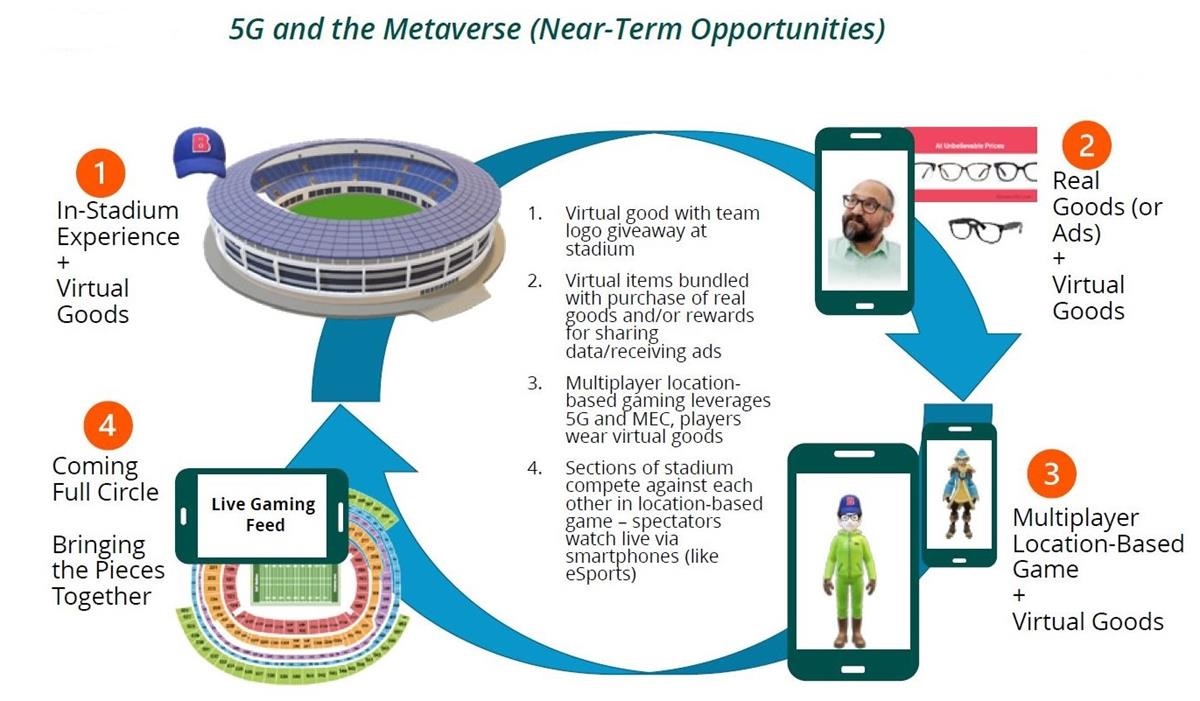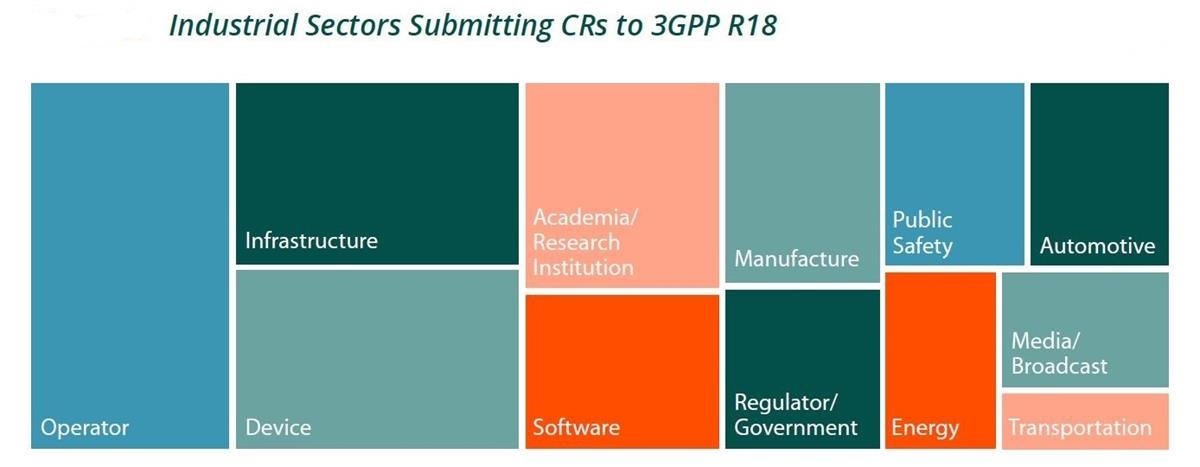
READ MORE: State of 5G Report: Enabling the Boundless Generation (InterDigital)
5G is set to generate $7 trillion in economic value by 2030 as it fuels a proliferation of connected devices — from smartphones and consumer electronics to enterprise applications — finds InterDigital and ABI Research’s new report, “State of 5G Report: Enabling the Boundless Generation.”
What’s more, it is “very likely” that this is a conservative estimate, according to the report, “because we cannot yet understand what types of services 5G will enable, particularly in the enterprise domain.”
5G has already reached 100 million subscriptions and is expected to achieve one billion subscriptions in 2023. Network slicing, service chaining, and private 5G will likely create “tremendous value” on top of these estimates and push the revenue significantly higher.

We are only scratching the surface of what is available with 5G, the report emphasizes.
As it stands now, a single 5G cell site can transfer 240 terabytes during a single day. That equates to 120,000 HD movies or 88,000 hours of 4K YouTube traffic per day.
“5G-Advanced and 6G will build on this foundation to create innovation we cannot yet imagine,” the report states. “5G will create new types of network effects in both consumer and enterprise domains. [Its] impact will likely be significantly higher than 4G and previous generations. It will not just be a faster network, but a completely new way to connect.”
Low Latency for High-Quality Video
Noting that 360-degree VR and volumetric video have been slower to take off than many expected, “diminishing some of this early excitement,” it’s suggested that “video may not be the most interesting opportunity for 5G.”
Instead, service providers should look to latency as “a key differentiator for new, cutting-edge live video streaming experiences.”

The opportunity for 5G (from viewers’ perspectives) will not come from traditional live broadcasts, which often have latencies in the sub-10 second range (live action to screen), but rather in new user experiences and use cases.
“Interactive video, video tied to betting and auctions, and video communications, for example, all require lower latencies for optimal UXs,” the report says, indicating that Netflix, eBay, YouTube, and others are making new efforts to introduced interactive video.
This includes e-commerce, where interactive communications between the presenter and audience, has already seen traction in markets like China and Southeast Asia.
“If recent efforts in other regions prove successful, live e-commerce will become a key driver for lower latency video streaming. While these experiences can work over fixed broadband, live experiences that are not tied to tighter scheduling will see more users accessing and interacting with these feeds via mobile devices on the go.”
Interactivity with social media (e.g., user-generated content, streamers, and influencers) also presents opportunities to position lower latency streaming and higher quality video as key selling points for 5G.
Location-Based Content
The rollout of 5G in sports stadiums and arenas “represents a critical connectivity upgrade to support high concentrations of users who are viewing live video (ultra-low latency required to match live on the field action) and sharing content through social media and real-time communication channels.”
5G-enabled cameras can also provide unique views of the field or areas of the stadium “to provide a premium viewing experience,” per the report.

“In addition to regular sports fans looking to consume more content, multiple views and replays can benefit sports bettors, who will want to analyze the action at a deeper level. The rollout of 5G in U.S. sports stadiums and arenas, in particular, is well positioned to take advantage of the growth in sports betting.”
5G and edge computing can also introduce new experiences and applications for fans and teams. Sensors can provide new data and information about athletes’ performance and training.
Additional levels of data could also be used by (and paid for by) sports bettors operating within the confines of league, team, and government rules and regulations.
“While many of today’s experiences are isolated to these venues these use cases represent early glimpses of what the buildup to the metaverse will offer when paired with 5G and edge computing.”
5G and Metaverse Opportunities in the Near Term
The arrival and eventual spread of mainstream smart glasses will yield the most transformative changes. This rollout will take time, as current projections only see the installed base of 5G-enabled smart glasses passing 60 million units by 2030.
InterDigital says the “metaverse is a longer-term vision (likely 2030+), but the buildup to this future and high-quality video are both well-positioned to reinvigorate the excitement and demand from consumers (and enterprise users) for what 5G can offer.
Watch This: The Next Big Jobs for 5G Networks
The first wave of 5G network buildouts is complete in the United States, and we’re on track to
reach 150 million subscriptions by the end of 2022.
Mobile broadband to smartphones and fixed wireless access where fiber does not go have dominated so far. In this video, Moor Insights & Strategy looks at two emerging “big jobs” for 5G networks: how to connect a spectrum of industries and connect the metaverse everywhere.
“Once this future arrives there will be significant changes across services, content, customer relationships, workflows, and how we interact with the environment. A pervasive display will create countless new touchpoints for video and information. Personalization, digital identity, and customer relationships will take center stage for marketing and advertising.”
All of these applications will push demand for connectivity (both in terms of data consumption and latency needs) and compute (cloud XR, personalization, processing of content, application acceleration).

Coming Next
The next stage of the 5G evolution (Release 18), targeted for December 2023, includes positioning improvements that aim to ultimately reach <10-centimeter accuracy, and Sidelink — a significant new introduction to cellular standards.
Sidelink grants device-to-device communications, allowing for new types of deployments which can lead to lower costs. Especially in the enterprise environment. It will extend network coverage through device-to-device communications and boost Vehicle-to-Everything (V2X) connectivity by enabling smartphones and wearables to communicate with vehicles.
In the Release 18 (R18) for 5G-advanced, Reduced Capability (RedCap) will extend 5G capabilities to power-constrained devices like smartwatches, machine vision cameras, AR/VR devices, and passive IoT devices. This will support asset tracking across both the enterprise and consumer markets.
NAB Show Announces Call for Proposals for 2023 BEIT Conference
By Amplify Content Team
Proposals for technical papers and panel sessions are now being accepted for the NAB Show Broadcast Engineering and IT (BEIT) Conference, taking place April 15-19, 2023 at the Las Vegas Convention Center. Selected papers will be presented during the program and included in the official “Proceedings of the 2023 Broadcast Engineering and IT Conference.”
The BEIT Conference at NAB Show is designed for broadcast engineers and technicians, media technology managers, contract engineers, broadcast equipment manufacturers and distributors, engineering consultants and R&D engineers. The conference focuses on technical issues facing today’s media professionals with an emphasis on the evolution of next-generation content delivery systems for radio, television and the broader media and IT ecosystem. Paper and session proposals may be submitted online through the 2023 BEIT Call for Papers and Panels portal.
Proposals explaining the underlying technologies used in new broadcast products or services will be considered. Proposals submitted for the purpose of promoting company products or services will not be accepted.
The deadline for proposals is November 4, 2022. Submissions accepted for presentation will be notified by January 20, 2023.
Proposal and abstract submissions for conference sessions, panels, exhibition floor theaters, speakers and other events are also being accepted for multiple NAB Show programs through November 4, 2022. For general session ideas, visit the NAB Show general Call for Speakers.
Importance of Standards
The report is largely flag waving for the importance of standards in building telecommunications networks, and in particular supports the Third Generation Partnership Project (3GPP). InterDigital makes its money by researching, devising, and owning patents, which feed into such standards.

“The patent process is an important step to achieve economies of scale and mass market adoption,” the report emphasizes. “It is equally important for companies to be the first filer for patents — especially essential patents — but also to produce R&D and innovation with the power to improve and push forward system designs deemed essential for future use cases and new UXs. This process is exactly why patents are necessary in the telecoms domain to ensure that innovation is accelerated and also rewarded.
“3GPP is the anchor that specifies the full standard and allows the global market to collaborate and compete on even terms. This is essential to drive the future of 5G and further allow customizations to be used across different markets.”

